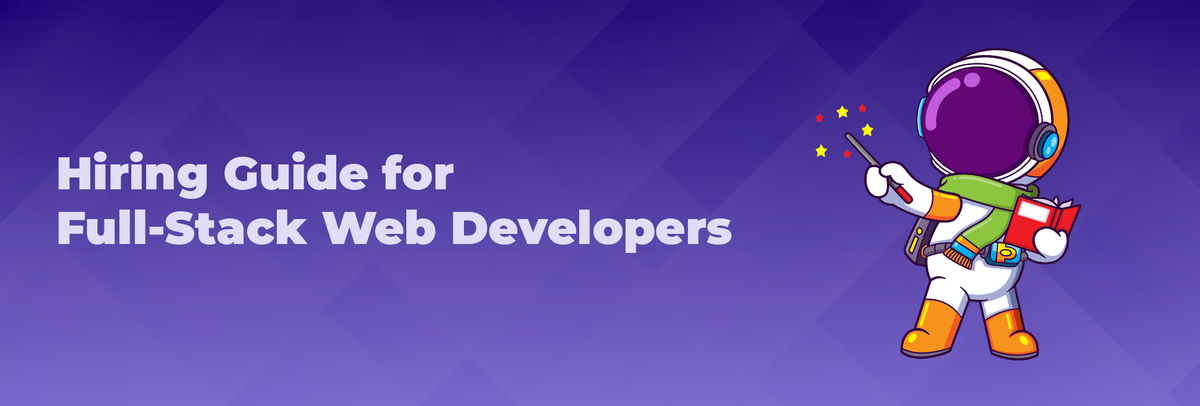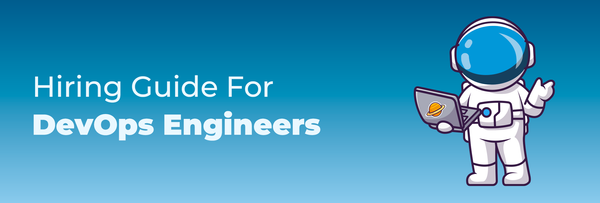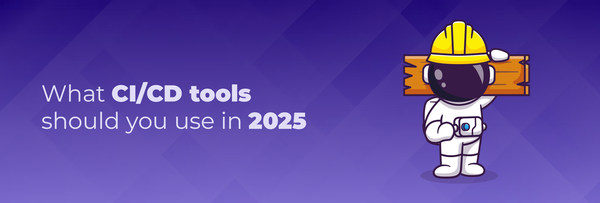Hiring Guide for Full-Stack Web Developers

Welcome to the Hiring Guide for Full-stack Web Developers. This blog is your go-to resource for building a strong full-stack team.
Whether you're embarking on a full-stack search or learning how to hire employees, we provide clear, practical advice.
Discover key strategies for employee hiring, from job descriptions to technical assessments, ensuring you find the right talent to power your projects.
Let’s get started and help you bring together the best team.
Who Are Full Stack Developers?
The demand for full-stack developers is ever-increasing.
According to the US Bureau of Labor Statistics, employment for web developers is projected to grow by 16% from now until 2032, reflecting the increasing need for skilled professionals in this field.
So who is a full-stack developer?
A full-stack developer is a versatile tech professional adept at front-end (client-side) and back-end (server-side) web development.
They possess a comprehensive skill set that includes programming languages, databases, and design frameworks, enabling them to manage the entire development process from concept to completion.
Web development comprises two main areas:
- Back-end development: Focuses on server-side operations, including APIs, databases, servers, and the core logic that powers websites and mobile applications.
- Front-end development: Involves user interface elements such as buttons, design, forms, and other graphical components.
Full-stack developers are proficient in front-end languages like HTML, CSS, and JavaScript, and have extensive knowledge of back-end technologies, including various frameworks, databases, and server-side scripting.
Full-Stack Developers Types Based on Tech Stack
Let’s have a look at different full-stack developer types based on tech stack.
- MEAN Stack
The MEAN stack is a JavaScript-based framework used for building scalable web applications.
MEAN stands for MongoDB, Express, Angular, and Node, the key technologies that comprise this stack:
- MongoDB: A NoSQL, object-oriented database designed for cloud applications.
- Express.js: A web application framework for Node.js, facilitating interactions between the front end and the database.
- Angular.js: A client-side JavaScript framework used to create dynamic web applications with interactive user interfaces.
- Node.js: A JavaScript runtime that builds scalable network applications.
- LAMP Stack
The LAMP stack consists of four open-source technologies commonly used to build web applications.
LAMP stands for Linux, Apache, MySQL, and PHP:
- Linux: The operating system.
- Apache: The web server.
- MySQL: The database server.
- PHP: The programming language.
Developers use the LAMP stack to create, host, and maintain web content, making it a popular solution for many websites.
- LEMP Stack
Similar to LAMP, the LEMP stack is an open-source web application stack.
LEMP stands for Linux, Nginx, MySQL, and PHP:
- Linux: The operating system.
- Nginx: Pronounced as "engine-x," a high-performance web server.
- MySQL: The database server.
- PHP: The scripting language.
LEMP is known for its strong community support and is widely used in scalable web applications.
- MERN Stack
The MERN stack is a popular JavaScript-centric framework for developing full-stack web applications.
MERN stands for MongoDB, Express, React, and Node.js:
- MongoDB: A scalable document database for storing data in JSON format.
- Express: A lightweight web application framework providing various development tools.
- React: An open-source front-end JavaScript library for building user interfaces based on components.
- Node.js: A JavaScript runtime environment for executing server-side code, allowing developers to use JavaScript for both the front end and back end.
The MERN stack offers a cohesive development environment known for its efficiency and reliability.
Its open-source nature ensures wide community support, continuous updates, and abundant resources.
Why Hire A Full-Stack Developer?
A full-stack web developer can handle both the front-end and back-end of web development, making them invaluable for streamlining the development process.
While they still require support from specialized roles, their comprehensive understanding of multiple technologies leads to more integrated and consistent outcomes.
Key Benefits of Full-Stack Developers
Full-stack developers are incredibly valuable for startups, SMEs, and large organizations alike.
They bring agility to development processes, which is essential for meeting the ever-changing demands of dynamic markets, particularly in startups and SMEs.
Additionally, in larger organizations working on innovative projects, their versatility enables quick prototyping and iterative updates, ensuring smooth project management.
Here are some of their key benefits:
- Cost-effectiveness: Hiring one competent full-stack developer is more economical than searching for multiple developers. It's particularly helpful for projects with limited budgets, and recruiting from regions with lower living expenses can further reduce costs.
- Flexibility:
Full-stack developers are adaptable and can work on any aspect of a project, delivering high-quality outcomes across the entire design framework.
They maintain and optimize existing systems, staying updated on the latest developments and technologies.
- Wide Range of Technology Skills:
Full-stack developers offer long-term solutions, knowledgeable about every layer of software development.
They can handle both front-end and back-end tasks efficiently, ensuring the successful completion of projects.
- Learning New Languages or Frameworks:
These developers stay updated with emerging technologies, constantly learning new languages, frameworks, and tools to remain competitive in the industry.
- Troubleshoot Errors:
Full-stack developers excel at identifying and fixing errors throughout the project development process, ensuring optimal performance.
So when is the best time to hire a full-stack developer for your business?
Table 1 - The best times to hire a full-stack developer
Guide To Hire A Full-Stack Developer
Essential Skills for Hiring a Full-Stack Developer
Technical Skills
Full-stack developers must possess a broad range of technical skills. Key areas of expertise include:
- Programming Languages: Proficiency in both front-end languages (such as PHP, Java, and HTML) and back-end languages (like Python, and Ruby).
- Development Frameworks: Familiarity with frameworks like Python Django, Java Spring, MyBatis, and Hibernate enhances their ability to build robust applications.
- Front-End Technology: Understanding user experience principles and front-end technologies, including product features and design styles, is crucial for creating user-friendly applications.
- Backend Technologies: In-depth knowledge of backend languages and the ability to manage server-side operations are essential for developing and maintaining web applications.
- Databases: Proficiency in working with databases is a must, with a solid understanding of at least one or two database systems.
- Debugging and Version Control: Skills in debugging and version control systems are vital for managing and tracking changes in code and ensuring smooth development workflows.
Soft Skills
Equally important are the soft skills that facilitate effective collaboration and communication.
A study by Harvard University, in collaboration with the Carnegie Foundation and Stanford Research Center, revealed that 85% of job success is attributed to possessing well-developed interpersonal and soft skills.
Here are some of the soft skills to look for when hiring developers.
- Problem-Solving: The ability to think critically and resolve issues efficiently.
- Time Management: Effective organization and prioritization of tasks to meet deadlines.
- Team Collaboration: Strong ability to work well within a team, contributing to group efforts and supporting colleagues.
- Emotional Intelligence: Understanding and managing one’s emotions, as well as empathizing with others to build positive working relationships.
- Adaptability: Flexibility to adapt to new challenges and changing environments.
- Continuous Learning: A commitment to ongoing personal and professional development, staying updated with the latest technologies and best practices.
Did you know that according to a LinkedIn survey, the five most sought-after soft skills are creativity, persuasion, collaboration, adaptability, and emotional intelligence?
Teamo’s Dynamic Technical Interview Process
Objective
Our 90-minute technical interview aims to thoroughly evaluate a candidate's technical skills, knowledge depth, and problem-solving abilities.
- Introduction (2-5 minutes)
- Welcome the candidate.
- Introduce yourself and your role in the company.
- Ask for a brief introduction from the candidate.
- Experience & Technical Communication (25 minutes)
Objective: Assess the candidate's previous experience, technical communication skills, curiosity, adaptability, and leadership qualities.
Experience Overview (10 minutes)
- Can you walk us through a significant project you've recently worked on? Describe the challenges, your role, and the outcome.
- How did you ensure the quality of your code in this project?
Technical Stack (10 minutes)
- Which technologies did you use in this project? Why were they chosen?
- Is there a technology you wish you could have integrated, and why?
- Why would you choose one technology over another?
Curiosity and Adaptability (5 minutes)
- How do you stay updated with the latest developments in technology?
- Describe a scenario where you had to learn a new technology on the job. How did you approach it?
- What is your methodology for working on new tasks or learning new skills?
- Checkpoint
Assess responses so far.
If they are not up to the mark, consider ending the interview early and inform the candidate that the position might not be a good fit.
- In-Depth Knowledge Assessment (25 minutes)
Objective: Explore various topics from the candidate's experience to gauge their expertise and breadth of knowledge.
Deep Dive on Technology (8 minutes)
- You mentioned using [specific technology]. Can you explain its workings and benefits in detail?
- How does [specific technology] compare to other similar technologies you've used?
Scenario-based Questions (10 minutes)
- Imagine you are facing [specific problem related to a technology you've mentioned]. How would you approach solving it?
- Can you recall a time when you optimized a system or process? How did you go about it?
Best Practices and Principles (7 minutes)
- What are the key best practices you follow when using [specific technology]?
- How do you ensure code maintainability and scalability in your projects?
- Do you follow clean code principles?
- What are your testing principles? What does a good test contain?
- Checkpoint
Reassess responses.
If they are not satisfactory, consider ending the interview early and informing the candidate that the position might not be a good fit.
- Technical Challenge (30 minutes)
Problem Introduction (5 minutes)
- Present the candidate with a well-defined technical challenge related to:
- System Design
- Database Design
- Frontend Architecture Designs
- SVG Design
Interactive Session (20 minutes)
- Allow the candidate to solve the problem on a shared coding platform or whiteboard.
- Encourage them to think aloud.
- Interact and ask questions about their approach, offering hints if needed.
Review and Feedback (5 minutes)
- Why did you choose this approach?
- How would you optimize this further?
- Assess how well they take constructive feedback.
- Conclusion (10-15 minutes)
- Thank you for sharing. Do you have any questions for us?
- Evaluate their questions for relevance and interest in the company.
- Inform them about the next steps:
- If they receive a +1 from the interviewers, they will move on to a 30-minute peer interview to determine fit with Teamo.
- If the outcome is negative, they will be informed via email and may reapply after six months.
Note
While maintaining a structured approach, ensure the conversation remains organic and insightful based on the candidate's responses.
Job Description: Full Stack Developer
Here is a sample job description that reflects the standard we follow at Teamo. You can modify it to suit your company's needs.
Hire A Full-Stack Web Developer With Teamo
Looking to hire top-tier full-stack web developers for your tech projects?
Look no further than Teamo, where our sophisticated methods ensure you get the best talent tailored to your needs.
Rigorous Screening Process
Our process begins with a global search for suitable profiles, focusing on candidates who not only meet technical requirements but are also available across all time zones, ensuring a diverse pool of applicants.
Comprehensive screening calls follow, assessing basic qualifications, technical skills, and cultural fit, filtering out candidates who don't align with Teamo's values.
Technical Evaluation
Those who pass move on to automated competency exams, verifying their technical knowledge and skills.
Next comes a rigorous 90-minute technical interview divided into three segments: technical communication, deep dive into specific technical knowledge, and problem-solving.
A 45-minute peer interview assesses cultural fit using the OCEAN model, ensuring alignment with Teamo’s values and remote readiness.
AI-Powered Skill Matching
The search for the right talent for your teams moves one step ahead with our AI-powered skill matching that maximizes candidates' potential for success and satisfaction in their new roles.
Quality Control
Rigorous quality control overseen by industry experts ensures technical proficiency and diversity, fostering innovation and a dynamic working environment.
Streamlined Recruitment Process
With Teamo, finding the perfect full-stack developer is a streamlined process, ensuring quality, fit, and the ability to grow with your team.
Dive into Teamo's strategic recruitment journey to enhance your capacity with top-tier talent from emerging markets.
FAQs
- What is Full Stack Web Development and How Does It Work?
Full stack development is a comprehensive approach where developers work on both the front-end and back-end of a web application, utilizing a wide range of technologies and tools.
This means they handle everything from designing user interfaces to managing databases and server-side logic.
With full-stack development tools, developers have the versatility to create end-to-end solutions efficiently.
- Is Full Stack Development Hard? How Can I Become a Full Stack Developer?
Becoming a full-stack developer requires dedication and a diverse skill set.
While it may seem daunting at first, with the right resources and commitment, anyone can learn the necessary skills.
Whether you're aiming to be an Amazon full stack developer, a PHP full stack developer, or any other type, self-teaching and structured learning programs can help you navigate the journey successfully.
- What Are the Qualifications and Requirements for Full Stack Developers?
The qualifications and requirements for full-stack developers vary depending on the specific role and company.
Generally, candidates should have a solid understanding of both front-end and back-end technologies, along with experience working with full-stack development teams.
Strong communication skills, problem-solving abilities, and adaptability are also essential.
Employers may look for candidates with expertise in specific full-stack developer languages and full-stack frameworks such as Java, Python, or JavaScript.
- How Long Does It Take to Become a Full Stack Developer and What Are the Career Opportunities?
The time it takes to become a full-stack developer depends on various factors, including prior experience, learning pace, and the resources available.
While some may achieve proficiency in a few months, others may take longer.
Career opportunities for full-stack developers are vast and diverse, ranging from working as freelancers or joining established companies to launching startups.
As the demand for end-to-end web development continues to rise, becoming a full-stack developer opens doors to a rewarding and dynamic career path.




